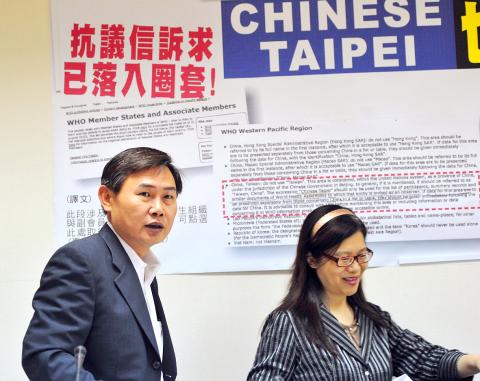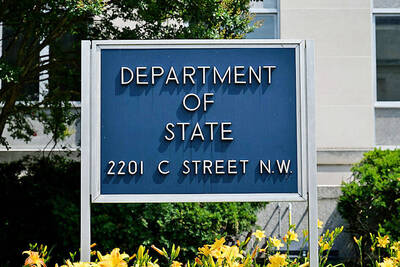The WHO has not wavered on its position that Taiwan is a part of China despite extending an invitation to the Department of Health under the designation “Chinese Taipei,” new information from the WHO reveals.
The stance, already evident from a leaked internal WHO memo released by Democratic Progressive Party (DPP) Legislator Kuan Bi-ling (管碧玲) last week, was strengthened by the new disclosure yesterday of the organization’s internal publishing policies that state Taiwan is “a province of China.”
“This area is considered, within the United Nations system, as a province of China under the jurisdiction of the Chinese government in Beijing,” the memo says, expressly forbidding WHO staff from simply using the term “Taiwan.”

Photo: CNA
The words “Chinese Taipei” should only be used for “a list of participants, summary records and similar documents of World Health Assemblies to which that entity is invited as an observer.”
Kuan said the information was further evidence that Taiwan’s breakthrough in attending the World Health Assembly (WHA) for the third year running has come at a hefty price.
Meant for WHO staff, the information is part of an internal Web site that informs officials on the “WHO house style” as part of the organization’s publishing policies. The Web page, which directs questions to the WHO’s legal team, was leaked by a source within the WHO, Kuan said.
The page was last updated on Feb. 23 this year, five months after senior WHO officials sent out a confidential memo asking agencies to be expressly aware that Taiwan is a “province of China,” pursuant to a prior closed-door arrangement with Beijing, Kuan said.
“The WHO controversy shows that Taiwan’s legal status is being eroded even as the governing party continues to mislead the [public] by playing games with our name,” Kuan said. “Taiwan’s sovereignty is being sold out — that’s an unavoidable and undeniable fact.”
Taiwan’s delegation to the WHA has formally protested about being lumped together with China, writing to WHO Secretary-General Margaret Chan (陳馮富珍) on Monday that its internal designation of “Taiwan, China” is a “mistake” and “absolutely unacceptable.”
The DPP labeled the protest “weak,” arguing that the controversy seriously undermines the nation’s international standing.
Chinese Taipei — Taiwan’s designation in most international organizations, including at the Olympic Games — has never before been seen as part of China, as the WHO information made clear, DPP lawmakers said.
The lawmakers have called for a boycott of the meeting that opened on Monday.
“Without adequately expressing our protest, I don’t feel that there is a way that Taiwan can attend the WHA,” DPP Legislator Lee Chun-yee (李俊毅) said. “What that would show is that we have completely given up on Taiwan’s sovereignty.”
Chinese Nationalist Party (KMT) lawmakers have called the DPP’s remarks “election rhetoric,” pointing out that the government has to keep in mind long-term interests when protesting the memo.
“I don’t think that getting angry is what the public expects the government to do,” KMT Legislator Lin Yi-shih (林益世) said. “Everybody must work together to think of ways to make this country better, instead of continuing with election ploys.”

A car bomb killed a senior Russian general in southern Moscow yesterday morning, the latest high-profile army figure to be blown up in a blast that came just hours after Russian and Ukrainian delegates held separate talks in Miami on a plan to end the war. Kyiv has not commented on the incident, but Russian investigators said they were probing whether the blast was “linked” to “Ukrainian special forces.” The attack was similar to other assassinations of generals and pro-war figures that have either been claimed, or are widely believed to have been orchestrated, by Ukraine. Russian Lieutenant General Fanil Sarvarov, 56, head

SAFETY FIRST: Double the number of police were deployed at the Taipei Marathon, while other cities released plans to bolster public event safety Authorities across Taiwan have stepped up security measures ahead of Christmas and New Year events, following a knife and smoke bomb attack in Taipei on Friday that left four people dead and 11 injured. In a bid to prevent potential copycat incidents, police deployments have been expanded for large gatherings, transport hubs, and other crowded public spaces, according to official statements from police and city authorities. Taipei Mayor Chiang Wan-an (蔣萬安) said the city has “comprehensively raised security readiness” in crowded areas, increased police deployments with armed officers, and intensified patrols during weekends and nighttime hours. For large-scale events, security checkpoints and explosives

PUBLIC SAFETY: The premier said that security would be tightened in transport hubs, while President Lai commended the public for their bravery The government is to deploy more police, including rapid response units, in crowded public areas to ensure a swift response to any threats, President William Lai (賴清德) said yesterday after a knife attack killed three people and injured 11 in Taipei the previous day. Lai made the remarks following a briefing by the National Police Agency on the progress of the investigation, saying that the attack underscored the importance of cooperation in public security between the central and local governments. The attack unfolded in the early evening on Friday around Taipei Main Station’s M7 exit and later near the Taipei MRT’s Zhongshan

REBUFFED: In response to Chinese criticism over recent arms sales, Washington urged Beijing to engage in meaningful dialogue instead of threats and intimidation Washington’s long-term commitment to Taiwan would not change, the US Department of State said yesterday, urging Beijing to stop pressuring Taiwan and engage in meaningful bilateral dialogues. The remarks came in response to a backlash from Beijing about Washington’s latest approval of arms sales to Taiwan. The US Defense Security Cooperation Agency said in a statement on Wednesday that the Taipei Economic and Cultural Representative Office in the US has asked to purchase an arms package, including Tactical Mission Network Software; AH-1W helicopter spare and repair parts; M109A7 self-propelled howitzers; HIMARS long range precision strike systems; tube-launched, optically tracked, wire-guided missiles; Javelin